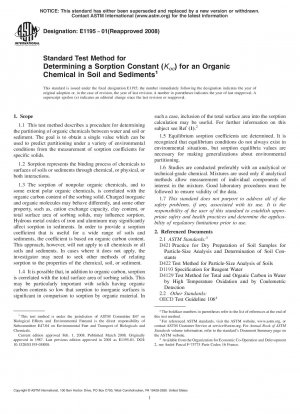ASTM E1195-01(2008)
Standard Test Method for Determining a Sorption Constant (Koc) for an Organic Chemical in Soil and Sediments
- Standard No.
- ASTM E1195-01(2008)
- Release Date
- 2001
- Published By
- American Society for Testing and Materials (ASTM)
- Status
- 2013-03
- Latest
- ASTM E1195-01(2008)
- Scope
Sorption data are useful for evaluating the migratory tendency of chemicals into the air, water, and soil compartments of our environment. They can be used in the prediction or estimation of volatility from water and soil, concentration in water, leaching through the soil profile, run-off from land surfaces into natural waters, and biological availability. Additional information concerning testing to determine sorption coefficients can be found in OECD Test Guideline 106 (7).
This test method assumes that sorption of at least nonpolar organic chemicals is mainly influenced by the organic matter of the soil or sediment solids. There is ample evidence in the literature to support this assumption, and the user of this test method should refer to Ref. (2) for more information on this subject. Organic carbon content is chosen as the basis for sorption instead of organic matter content. This is because organic carbon values generally are measured directly by analytical methods. Organic matter may be estimated by multiplication of the organic carbon values by a somewhat arbitrary constant of 1.7 (3). This test method is based on the assumption that all of the material sorbed to the solids is reversibly bound. The analyses described herein assume equilibrium between the liquid and solid concentrations of the test compound. In some cases, there may be a fraction of the compound that is irreversibly bound to the solids. For these cases, the measurements made by the test may not reflect a true “equilibrium”. The irreversible sorption phenomena has been extensively documented and the reader is referred to (9), (10) and (8) for more discussion on this topic.
A sorption constant is obtained and is essentially independent of soil properties other than organic carbon. This value is useful because, once it is determined, the sorption distribution characteristics for any solid can be estimated based on its organic carbon content.
This test method is designed to evaluate sorption at environmentally relevant concentrations as a function of organic carbon content of different soil and sediment solids. Therefore, the number of different solids is emphasized in the procedure rather than the number of chemical concentrations studied with each solid. In general, one concentration is employed since the test method assumes that at low solution concentrations, sorption isotherms approximate linearity and sorbed concentrations do not exceed typical environmental loading. Errors arising from concentration effects at low environmental concentrations usually are less than the variation existing between different solids, when dealing with sorption trends in a general manner. Therefore, the initial concentration of the test chemical in solution should not exceed 0.5 of its water solubility.
As an option, a procedure is given for determining concentration effects on sorption. This is because high concentrations may be present in certain environmental situations; such as landfills and spills. This procedure should be done at four concentrations over a hundred fold concentration range (for example, 0.1, 0.5, 2, and 10 ppm initial solution concentration). If low solubility presents analytical difficulties, solution concentrations should range over at least one order of magnitude. The Freundlich equation is an appropriate expression of these effects:

where: Ca =........ ASTM E1195-01(2008) Referenced Document
- ASTM D1193 Standard Specification for Reagent Water
- ASTM D4129 Standard Test Method for Total and Organic Carbon in Water by High Temperature Oxidation and by Coulometric Detection
- ASTM D421 Standard Practice for Dry Preparation of Soil Samples for Particle-Size Analysis and Determination of Soil Constants
- ASTM D422 Standard Test Method for Particle-Size Analysis of Soils
ASTM E1195-01(2008) history
- 2001 ASTM E1195-01(2008) Standard Test Method for Determining a Sorption Constant (Koc) for an Organic Chemical in Soil and Sediments
- 2001 ASTM E1195-01 Standard Test Method for Determining a Sorption Constant (Koc) for an Organic Chemical in Soil and Sediments
- 1987 ASTM E1195-87(1993)e1 Standard Test Method for Determining a Sorption Constant (Koc) for an Organic Chemical in Soil and Sediments

Copyright ©2024 All Rights Reserved